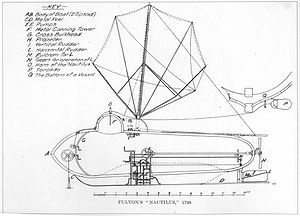Robert Fulton
Robert Fulton (November 14, 1765 – February 24, 1815) was a U.S. engineer and inventor who is widely credited with developing the first commercially successful steam-powered steamboat. He also designed a new type of a steam warship. In 1800 he was commissioned by Napoleon Bonaparte to design Nautilus [1], which was the first practical submarine in history[2].

Early life
Robert Fulton was born in Mifflin County, Pennsylvania in 1765. He may have become interested in steamboats in 1777 when (at the age of 12) he visited William Henry of Lancaster, Pennsylvania, who had found out about Watt's steam engine on a visit to England; Henry then made his own steam engine and in 1763 – two years before Fulton was born – tried putting it in a boat, which sank.

When he came of age, Fulton went to England in 1786 to study painting. There he met James Rumsey who sat for a portrait in the studio of Benjamin West, where Fulton was apprenticing. Rumsey was an inventor from Virginia who ran his first steam boat in Shepherdstown, (now West) Virginia in 1786 and repeated his test again on December 3 1787. As early as 1793 Fulton proposed plans for steam vessels to both the United States and the British Governments, and in England he met the Duke of Bridgewater, whose canal would shortly be used for trials of a steam tug, and who later ordered steam tugs from William Symington. Symington had successfully tried steamboats in 1788, and it seems probable that Fulton would have been well aware of these developments.
Later years
In 1797 Fulton went to France (where the Marquis Claude de Jouffroy had made a working paddle steamer in 1783) and commenced experimenting with submarine torpedoes and torpedo boats.
In that year he met Robert Livingston, United States Ambassador (whose niece he married her name was Harriet Livingston,they had four children; Robert, Juila, Mary, and Cornelia), and they decided to build a steamboat to try out on the Seine. Fulton experimented with the water resistance of hull shapes, made drawings and models and had a steamboat constructed. At the first trial it sank, but the hull was rebuilt and strengthened, and on August 9, 1803, this boat steamed up the River Seine. The boat was 66 feet (20 m) long, 8 feet 2.4 m) beam and made between 3 - 4 M.P.H. (5 - 6 km/h) against the current.
In 1807, Fulton and Livingston built the first commercial steamboat, the North River Steamboat (later known as the Clermont), which carried passengers between New York City and Albany, N.Y
Memorialization


Fulton is buried at the Trinity Church Cemetery in New York City alongside other famous Americans such as Alexander Hamilton. In 1816, the state of Pennsylvania donated a marble statue of Fulton to the National Statuary Hall Collection in the US Capitol Building.
A wide number of places are named for Robert Fulton, including (but not limited to):
- Robert Fulton Fire Company, Fulton Township, Lancaster County Pa.
- Robert Fulton Drive in Columbia, Maryland
- Fulton Street in Brooklyn
- Fulton Street in Manhattan
- Fulton Street in Massapequa Park, NY
- Fulton Street in New Orleans
- Fulton Street in Alcoa, Tennessee
- Fulton Street in San Francisco, CA
- Fulton County, Georgia
- Fulton County, Indiana
- Fulton County, Kentucky
- Fulton County, Ohio
- Fulton County, Pennsylvania
- Fulton County, New York
- Fulton, Missouri
- Fulton, Oswego County, New York
- Fulton, Schoharie County, New York
- Fultonham, Ohio
- Fulton Township, Lancaster County, Pennsylvania
Fulton, MS
- The proto-type to the U.S. Navy's A-Class Submarines was named after Robert Fulton... circa 1900 - which ended up in the hands of the Russian Navy by 1905.
References
- Robert Fulton Birthplace
- An article on Fulton and the War of 1812
- A history of the growth of the steam-engine
- William Symington
- A Treatise on the Improvement of Canal Navigation, 1796. From the University of Georgia Libraries in DjVu & layered PDF formats.
- A Treatise on the Improvement of Canal Navigation 1796. From Rare Book Room.
- CHAPTER XIII: ROBERT FULTON in Great Fortunes, and How They Were Made (1871), by James D. McCabe, Jr., Illustrated by G. F. and E. B. Bensell, a Project Gutenberg eBook.
